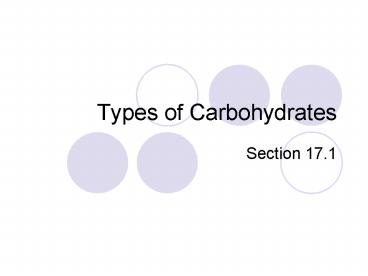Types of Carbohydrates - PowerPoint PPT Presentation
1 / 31
Title:
Types of Carbohydrates
Description:
Title: Types of Carbohydrates Author: WESTONK Last modified by: SVSD Created Date: 3/6/2006 2:47:36 PM Document presentation format: On-screen Show – PowerPoint PPT presentation
Number of Views:187
Avg rating:3.0/5.0
Title: Types of Carbohydrates
1
Types of Carbohydrates
- Section 17.1
2
Four Types of Carbohydrates
- Monosaccharides
- Contain a single sugar unit
- Examples glucose and fructose
- Disaccharides
- Contain two monosaccharides units joined through
bridging oxygen atoms AKA glycosidic bond - Examples sucrose and lactose
3
Four Types, continued
- Oligosaccharides
- Three to ten monosaccharide units joined by
glycosidic bonds - Polysaccharides
- Long, often highly branched, chains of
monosaccharides - Examples starch, glycogen, and cellulose
4
Monosaccharides
- Composed of carbon, hydrogen and oxygen
- Most follow the general formula (CH2O)n
- All names end in ose
- Two types
- Ketose monosaccharide that contains a ketone
carbonyl group - Aldose monosaccharide that contains an aldehyde
carbonyl group
5
Ketose OR Aldose?
6
Ketose OR Aldose
7
Another system number of carbons
- Another system of nomenclature tells us the
number of carbon atoms in the main skeleton. - 3 carbon triose
- 4 carbon tetrose
- 5 carbon pentose
- 6 carbon hexose
- Etc.
8
Triose, tetrose, pentose, etc?
9
Answers
Triose
Pentose
Hexose
10
Combining the two systems
Aldose Triose Aldotriose D-Glyceraldehyde
Aldose Hexose Aldohexose D-Glucose
Ketose Hexose Ketohexose D-Fructose
11
Chiral Objects
- Chiral compounds have the same number of atoms
arranged differently in space. - A chiral carbon atom has four different groups
attached.
12
Mirror Images
- The three-dimensional structure of a chiral
compound has a mirror image. - Your hands are chiral. Try to superimpose your
thumbs, palms, back of hands, and little fingers.
Is it possible? Why or why not?
13
Chiral or NOT?
- Determine if there is a chiral carbon in each
compound. - A B
14
Solution
- A Yes, 4 different B No, the
- groups are attached 2 H atoms
- to the second C atom are identical
15
D and L Notation
- D,L tells to which of the two chiral isomers we
are referring. - If the OH group on the next to the bottom carbon
atom points to the right, the isomer is a
D-isomer if it points left, the isomer is L. - The D form is usually the isomer found in nature.
16
D notation
17
Glucose
18
Homework
- Complete problems 17.3 and 17.4 on page 472
17.5 and 17.6 on page 474-5 17.24, 17.25, and
17.26 on page 493
19
Importance of Glucose
- Most important sugar in the human body.
- Glucose is broken down in glycolysis and other
pathways to release energy for body functions - The concentration of glucose in the blood is
carefully controlled by insulin and glucagon. - Normal blood glucose levels are 100-120 mg/100mL
20
Importance of Glucose
- Insulin stimulates the uptake of the excess
glucose by most of the cells in the body. - 1-2 hrs after eating the glucose levels return to
normal. - If glucose concentrations drop too low, the
individual feels lightheaded and shaky. When
this happens, glucagon stimulates the liver to
release glucose in the blood.
21
Diabetes / Hypoglycemia and Glucose
- Type I diabetes or diabetes mellitus caused by
the inability to produce the hormone insulin If
untreated, end up with high blood sugar - Type II diabetes or adult-onset diabetes caused
by insulin resistance (body fails to properly use
insulin) combined with a relative insulin
deficiency If untreated, end up with high blood
sugar - Hypoglycemia caused by the over excretion of
insulin in response to a rise in blood sugar If
untreated, end up with low blood sugar
22
Structure of glucose
- In reality, the open-chain form of glucose is
present in very small concentrations in cells. - In most cases, the cyclic intramolecular
hemiacetal is formed. - The hydroxyl group on C-5 reacts with the
aldehyde group to form a hemiacetal. - Two isomers are formed because a new chiral
carbon is created.
23
6
a-D-glucose
5
1
1
4
2
6
2
3
3
5
4
1
4
5
2
6
3
D-glucose
ß-D-glucose
24
Haworth Structure for D-Glucose
- Write OH groups on the right (C2, C4) down
- Write OH groups on the left (C3) up
- The new OH on C1 has two possibilites down for
? form, up for ? form
25
a-D-glucose
O
26
ß-D-glucose
O
27
You Try This One!
- Write the cyclic form of ?-D-galactose
28
Solution ?-D-galactose
O
29
Benedicts reagent
- Benedicts reagent a basic buffer solution that
contains Cu2 ions - It readily oxidizes the aldehyde group of aldoses
to form a brick red Cu2O precipitate. - It will also oxidize ketoses because of the OH
group on the carbon next to the carbonyl group.
30
Reducing Sugars
- Reducing sugar a sugar that can be oxidized by
Benedicts reagent - All monosaccharides and the common disaccharides
(except sucrose) are reducing sugars.
31
Use of Benedicts reagent
- Benedicts reagent was commonly used to
qualitatively monitor excess glucose in the urine
by diabetics to insure proper dosage of insulin.
- These have been replaced by blood glucose tests
that are more accurate.































